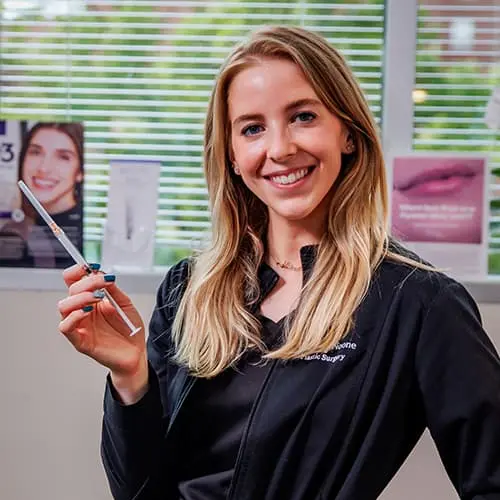BOTOX® and Injectables for Men (Neuromodulators & Dermal Fillers)
As a man, the last thing you want is to look like you had work done. Still, you are aware of the signs of aging, especially the lines that become etched into your skin over time. The truth is that Botox® and injectables do not have to look fake, and many men get these treatments because they allow them to look refreshed and younger without requiring a high-maintenance skincare routine or surgery. Botox lasts 3-4 months, and dermal filler can last a year or longer, depending on the formula. With a brief appointment to touch up your injectables, you can stop worrying about your appearance and focus on the things that matter most to you.
Botox for men
If you are starting to notice lines and folds form in your face, an effective way to treat and prevent wrinkles is Botox, a.k.a. “Brotox.” Dysport®, Xeomin®, and Jeuveau® are neuromodulators that work similarly. Botox (or neurotoxin) is injected into the muscles that cause wrinkles, and it works by blocking nerve signals to the muscle and causing it to temporarily relax. (It is also used for a number of medical reasons, including to curb excessive sweating.) Men typically have stronger muscles than women, and therefore require a stronger dose of Botox. We carefully examine your individual wrinkles and expressions to determine our injection pattern and amounts. We inject each area with just enough neurotoxin to smooth the wrinkle while allowing you to continue to form your natural expressions.
Dr. R. Brannon Claytor
Dr. Claytor is board certified by the American Board of Plastic Surgery and holds over 20 years of experience as a cosmetic plastic surgeon. An innovator and teacher in the field of plastic surgery, he uses advanced techniques like the drain-free tummy tuck and deep plane facelift to streamline recovery and provide natural-looking, durable results.




Where is Botox used?
The most common areas where men request Botox injections include:
- The forehead
- The “crow’s feet” lines in the corners of the eyes
- The “11s” between the eyebrows
What is Botox like?
Your Botox will be injected with a very small needle; it is a very tolerable treatment, usually performed with no anesthesia or numbing medication. The most common side effects are headaches and bruising or redness at the sites of injection. You will begin to see your results in about 24-48 hours, with full results visible within 30 days. Depending on how active your muscles are, Botox can last between 3 and 4 months, with some variation from person to person depending on how active your muscles are.
Is Botox safe?
Yes, Botox is safe. It is composed of a highly purified botulinum toxin type A that, once injected into a muscle, spreads about 1 cm and stops nerve signals to the muscle. In this way, Botox relaxes the muscle locally. The more neuromodulator that is injected, the stronger the effect will be.
- Key Benefits
- Glossary
- Smoother skin: Reduce wrinkles and fine lines to promote a younger appearance
- Non-surgical: Minimally invasive with no need for surgery, providing quick and straightforward improvement
- Fast recovery: Minimal downtime, allowing men to return to daily activities almost immediately
- Subtle results: Provides natural-looking results, helping men appear refreshed without looking “done” or “frozen”
Botox: A branded name for botulinum toxin, which is used for various therapeutic and cosmetic purposes.
Botulinum Toxin: The active ingredient in Botox, a protein that temporarily relaxes muscles when injected in small amounts.
Glabellar Lines: Vertical lines between the eyebrows, often referred to as “frown lines.”
Crow’s Feet: Lines that appear at the outer corners of the eyes, especially when smiling or squinting.
Hyperhidrosis: A medical condition characterized by excessive sweating, which can be treated with Botox.
Injection Site: The specific area where Botox is injected to achieve desired results.
Muscle Atrophy: The gradual loss of muscle mass, often a desired effect in areas where Botox is administered.
Dermal Fillers: Injectable substances used to fill in or plump up areas of the skin, not to be confused with Botox, but sometimes used in conjunction with it.
Reconstitution: The process of preparing the botulinum toxin for injection, typically by diluting it with saline.
Unit: The measurement used to quantify Botox; different areas of the face require different units for effective treatment.
OnabotulinumtoxinA: The generic name for Botox.
Dysport, Xeomin: Other brands of botulinum toxin with slightly different properties and uses.
Cosmetic Surgeon: A medically qualified practitioner who specializes in surgeries that aim to improve the aesthetic appearance of a patient.
Contraindications: Factors or conditions that serve as reasons to withhold a certain medical treatment due to the harm it would cause the patient.
Blepharospasm: Involuntary tight closure of the eyelids, a condition sometimes treated with Botox.
Collagen: A protein naturally found in the skin, providing it with structure and elasticity.
Granulomas: Small, firm nodules that may form under the skin as a reaction to a foreign substance, like dermal fillers. These are usually benign but may cause cosmetic concern.
Injection Site Reactions: Side effects occurring at the location where dermal fillers are injected. These can include redness, swelling, bruising, pain, or itching, typically resolving within a few days.
Intradermal Injection: A procedure where substances are injected into the dermis, the layer of skin located beneath the epidermis.
Biocompatible: A term describing substances that can coexist with living tissues without causing harm or adverse reactions.
Dermal fillers for men
Dermal fillers are injectable gels that are carefully and precisely injected to physically sit below the skin to fill wrinkles, rebuild lost volume in your skin, or add dimension to your features. Used throughout the face, dermal filler treatment is sometimes called a “liquid facelift.” Before your dermal filler treatment, we will usually apply a numbing cream to help you feel comfortable during the injection. Side effects are usually temporary and mild, such as mild swelling where your injections were placed, redness, tenderness, lumps, or bruising. Any side effects typically subside within a week.
What are fillers used for?
There are two primary ways that filler can be applied: fillers can treat wrinkles in the mid to lower face, and they can rebuild volume in areas where balance is needed.
For those who want to appear younger and more energized, here are a few ways we can refresh your appearance with filler injections:
- Smooth the smile lines, or nasolabial folds
- Restore skin thickness in sunken cheeks
- Smooth deep creases below the eyes (tear troughs)
For men who want to enhance their looks, we can strengthen features such as your jawline and balance your proportions to help you look confident. Here are some other ways we can enhance your features with dermal filler:
- Sharpen the jawline
- Widen the chin
- Create a more square jaw
- Improve the nose shape with a “non-surgical nose job”
- Sculpt a masculine profile by balancing the projection of the nose and chin
- Strengthen a recessed chin for better balance of your features
Julie Holesh, PA
Physician assistant Julie Holesh is board-certified by the National Commission on Certification of Physician Assistants. With both an artistic eye and medical expertise, she can help you achieve optimal skin quality with injectables, laser treatments, and other med spa services.
Your dermal filler options at Claytor Noone Plastic Surgery
When you arrive for your injectable treatment, we evaluate your skin and select the best formula for your needs, as each formula is optimized for a specific use. The dermal fillers that we currently offer include Juvéderm®, Restylane®, Sculptra®, Bellafill®, and RHA Filler:
- Juvéderm and Restylane are made of hyaluronic acid, a chemical that is naturally present in your skin. Both of these products come in numerous consistencies for treating different areas (hence products like Restylane Lyft and Restylane Silk) and last about 6-12 months.
- Sculptra is a poly-L-lactic acid (PLLA) collagen stimulator, meaning that it works with your skin to help rebuild its collagen structure. Scultra lasts up to 2 years.
- Bellafill is composed of polymethyl methacrylate (PMMA) microspheres in a collagen gel that forms a scaffolding where your skin grows more collagen over time, and is therefore a longer-lasting formula—as long as 5 years.
- RHA fillers are a simpler form of hyaluronic acid based fillers which are designed to offers long-lasting improvement to dynamic wrinkles in the lower face, such as the naso-labial folds that extend from the nose to the mouth. These fillers last up to 15 months.
How we customize Botox and dermal filler injections for men
Many men are getting injectables to help them stay competitive in the workforce and confident in their personal life. With injectables, we keep you looking natural while smoothing wrinkles (and even enhancing your strong features) to help you look more youthful and energized. Men have natural differences to their skin and muscles, so you require an experienced injector of Botox and dermal filler who knows how to give you a natural-looking, masculine result.
Most men ask us for a subtle relaxing of their wrinkles. Where some women may prefer a silky-smooth appearance to their skin, arched eyebrows, and plump cheeks and lips, men want to continue to form their facial expressions want filler results that look natural. We use injection techniques that carefully under-treat men’s concerns to accomplish this natural appearance, while also taking into account men’s facial muscle strength in our dosing of Botox
At Claytor Noone Plastic Surgery, board certified Philadelphia plastic surgeon Dr. Brannon Claytor or physician assistant Julie Holesh perform all injectable treatments. Both are experienced aesthetic specialists with special training in injectables, meaning that you can trust you are in skilled hands. We provide a full range of premium injectables to meet your goals for your appearance, including Botox, Xeomin, DAXXIFY, Dysport, and Kybella, as well as the dermal fillers Juvéderm®, Restylane®, the RHA® filler collection, Sculptra Aesthetic, and Bellafill®. We carefully examine your face and your expressions in order to gauge both where to place your injectables and how much of each formula to use. Our goal is to help you feel more confident—while still looking like yourself.
Why choose Dr. Claytor for your plastic surgeon?
Double Board-Certified for a high level of safety and precision
Chief of Plastic Surgery at Main Line Health, a top health system
Board Member of The Aesthetic Society, shaping the future of aesthetics
8x Philadelphia Magazine Top Doctor for exceptional patient care
Recognized as one of America’s Best Plastic Surgeons by Newsweek
Drain-free recovery expert for faster, more comfortable healing
Deep plane facelift innovator and global educator
Active researcher in surgical and non-surgical aesthetic advancements
Highly regarded for his surgical expertise and outcomes, as well as his dedicated follow-up care





Each of these treatments and techniques requires expertise in men’s facial anatomy and aesthetic preferences. It is also critical to choose an injector who has experience with the range of injectables themselves, and who will choose the best formula for your desired outcome. Philadelphia board certified plastic surgeon Dr. R. Brannon Claytor has over 20 years of experience offering cosmetic plastic surgery procedures to patients from Philadelphia, Bryn Mawr, Main Line, and the surrounding areas. A member of The Aesthetic Society’s Board of Trustees, the American Society of Plastic Surgeons (ASPS), and a Fellow of the American College of Surgeons (FACS), Dr. Claytor is dedicated to continuously advancing his surgical and non-surgical techniques and teaching his methods to colleagues at national meetings. In addition to his surgical work, Dr. Claytor the Chief of Plastic Surgery for Main Line Health Systems, and is a Clinical Associate Professor at Lankenau Institute of Medical Research.
Dr. Claytor and our team are here to help you look as good as you feel. To get started, call our Bryn Mawr office at (610) 527-4833 or fill out our online contact form today.
References »
Flynn TC. Botox in men. Dermatology and Therapy. 2007 Nov-Dec;20(6):407-13. doi: 10.1111/j.1529-8019.2007.00156.x.
Hamman MS, Goldman MP. Minimizing bruising following fillers and other cosmetic injectables. The Journal of Clinical and Aesthetic Dermatology. 2013 Aug;6(8):16-8.
Flynn TC. Botulinum toxin: examining duration of effect in facial aesthetic applications. American Journal of Clinical Dermatology. 2010;11(3):183-99. doi: 10.2165/11530110-000000000-00000.
Fabi SG, Cohen JL, Green LJ, Dhawan S, Kontis TC, Baumann L, Gross TM, Gallagher CJ, Brown J, Rubio RG. DaxibotulinumtoxinA for Injection for the Treatment of Glabellar Lines: Efficacy Results From SAKURA 3, a Large, Open-Label, Phase 3 Safety Study. Dermatologic Surgery. 2021 Jan 1;47(1):48-54. doi: 10.1097/DSS.0000000000002531.
Green JB, Mariwalla K, Coleman K, Ablon G, Weinkle SH, Gallagher CJ, Vitarella D, Rubio RG. A Large, Open-Label, Phase 3 Safety Study of DaxibotulinumtoxinA for Injection in Glabellar Lines: A Focus on Safety From the SAKURA 3 Study. Dermatologic Surgery. 2021 Jan 1;47(1):42-46. doi: 10.1097/DSS.0000000000002463.
Areas Served:

Medically reviewed by Dr. R. Brannon Claytor — Updated on Oct 28, 2024



